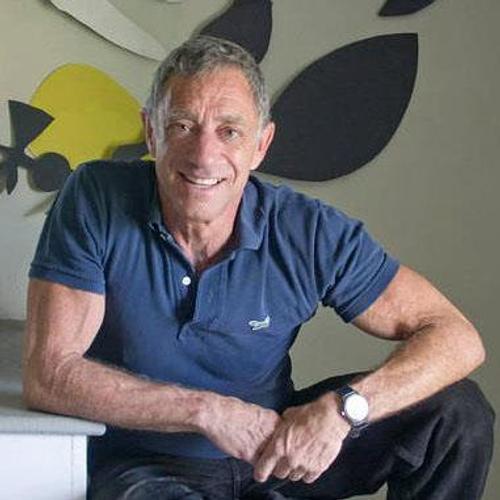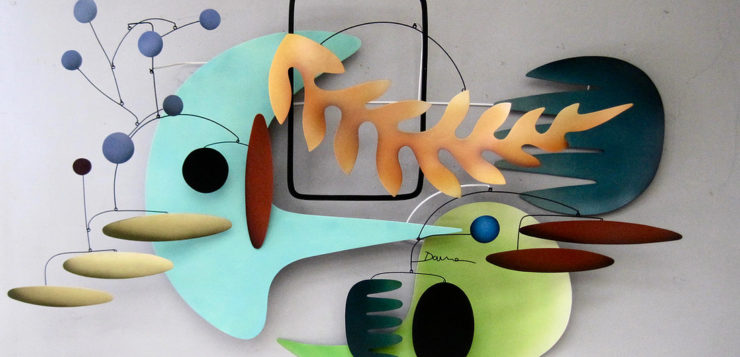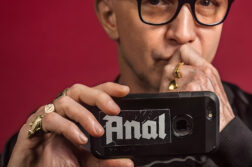MARK DAVIS has been making mobiles out of his studio in the Roslindale section of Boston for almost thirty years. He began making “three-dimensional art” as a boy growing up gay in Indiana. His work has evolved into a unique and original approach that employs color, whimsy, and playfulness to create works of stunning beauty and grace, and of course, balance.
 His public art includes major installations like Healing Waters, which hangs at the Ann and Robert H. Lurie Children’s Hospital of Chicago. He began his career making jewelry that was featured in major New York department stores and in the pages of Vogue. Along the way he found mentors within the LGBT community who offered inspiration and encouragement. Mark discusses here his relationship with Gene Moore, the man behind the iconic Tiffany window displays, who helped him find his current success as a mobile artist.
His public art includes major installations like Healing Waters, which hangs at the Ann and Robert H. Lurie Children’s Hospital of Chicago. He began his career making jewelry that was featured in major New York department stores and in the pages of Vogue. Along the way he found mentors within the LGBT community who offered inspiration and encouragement. Mark discusses here his relationship with Gene Moore, the man behind the iconic Tiffany window displays, who helped him find his current success as a mobile artist.
This interview was conducted late last year via Zoom link. — AC
Art Cohen: When did you start making art?
Mark Davis: As with a lot of gay kids that have difficult childhoods and traumas, art is what saved me. I was doing very good pencil and pen-and-ink drawings of realistic things, very intense, brooding figures. I got little awards in local contests. I’m very proud of them today. That’s what I was doing in my bedroom as I started getting high all the time. I was smoking a lot of pot and doing LSD.
AC: When did you first start making mobiles?
MD: I started making mobiles right around the same time that I started taking LSD. I was in junior high school. I found a book in the library on Alexander Calder. It’s one of those cathartic moments in your life. I took the book off the shelf, saw this mobile on the cover, and immediately understood it. I went home and I started making the mobiles in the book. They were a little clunky, but I knew how to balance them.
AC: Aside from your early artwork, what else should we know about your childhood?
MD: We lived out in the country in Indiana. My mom was a professional musician. She played medieval music. She was a child prodigy. She was also bipolar, and finally took her own life. It was very painful. I was in my early twenties. My dad was a college professor who taught English and medieval literature. But he was a bit of a tyrant. We moved all around the East Coast. He taught at Harvard, Yale, MIT, Williams, a lot of the big colleges. He’d stay there for two or three years and then they’d fire him because he was such an asshole. Then off to Indiana, to Notre Dame.
AC: Back to the artwork: what sort of exposure to art did you have as a child?
MD: They often took us to museums, but only to the Renaissance and medieval collections. And that was it. A little constrained æsthetically. We didn’t have any understanding of contemporary art. We had no TV, no magazines, no newspapers. Their message was: “Stay away from the world. It’s a bad place. And it’s better not to know about it.”
AC: But at some point you figured out your were gay. When did that happen?
MD: At ten, although I hadn’t had any experiences. Everyone else in school also knew. They would call me a fag and I’d ask, “Dad, what’s a fag?” There were no out gay people. This was in the late ’60s, early ’70s, in Indiana.
AC: What happened when you finally told your parents?
MD: They were like: “Oh, my God, talk to our psychiatrist!” Which I did, and he said: “Hmm, sounds like you’re homosexual. Nothing wrong with you. You got to go meet other people like you.” “How do I do that?” I asked. “I don’t know, but that’s what you’ve got to do.”
AC: What an enlightened psychiatrist for the ’70s. What about college?
MD: I went to Goddard College in Vermont, in the boondocks. I lasted about eight months. I was the rebellious, angry, acting-out kind of kid, and I was not pretty. I had this long, greasy hair, a thick unibrow, wire-rim glasses, and a big beard. I never used deodorant; didn’t believe in it and stunk to high heaven. I bought a red dress at a thrift store; it had a zipper down the front. I would zip and unzip it to show my hairy chest. I wore my combat boots and put on blue eyeshadow and tramped around campus. Nobody would talk to me. I must have given off this look of absolute anger.
AC: When did you start making jewelry, and how did that career get started?
MD: When I was still at home, I would make these necklaces and earrings and stuff, and my mom would wear them and give them to her friends. They were made out of steel wire, not the right stuff to use. But when I was at Goddard, there was a basement room that had an unused jewelry studio. I met a really cool lesbian who taught me how to solder with silver.
By the age of thirty, I was showing at Saks, Bloomingdale’s, Henri Bendel, all the big stores in New York. There was a period in the ’80s when everybody was wearing wild, chunky jewelry. What I was doing was sort of hand-painted pieces, marbleized paint on metal, signed by the artist. It was very unusual; there was nothing like it. I was written up in magazines like Vogue. Once a month I would visit their offices to show them what I was doing, and they would take a bunch of work and put them on models and show them in the magazine. One visit, when I was living out in rural Massachusetts I had on a corduroy jacket and at one point I could smell the wood smoke, because I heated with a wood stove. Here are all these elegant, glamorous women. I was kind of a shy, sweet, ambitious kid, and they must have liked that.
AC: When did you switch to making mobiles?
MD: The big turning point for me was meeting Gene Moore through a friend. He was a huge mentor to me, not in terms of anything concrete, but just somebody who believed in me, who was in a very high position, and who had an incredible æsthetic. I told him I was done with the jewelry, and he said I should focus on the mobiles: “Number one, you’re way better than you realize. Number two, nobody’s doing it. Make some for the Tiffany windows; I’ll put them in and that’ll be your start. You have to take it from there.” And I did.
AC: You ended up having a relationship with him. What do you remember of your first meeting?
MD: I went up the elevator to the penthouse of Tiffany’s. A glamorous secretary said: “Oh, yes, Mr. Moore will see you now.” Above the door hung a sign that said: “No one sees the wizard. Not ever!” Behind the door, a room with a fourteen-foot ceiling. Huge French doors opened onto a little balcony covered with plants. It was dark, with a little light on his big desk. The room was filled with smoke because he chain-smoked cigarettes. There were stuffed owls and old books all over the place, just like an alchemy shop. He had a little toupee, rings, and a Gucci suit. “Let’s see what you got. Oh, yes, fabulous! Fabulous! What do you want me to do?” I said, “I really would like to just come to New York and work in the fashion business.” And he replied: “Oh, God, don’t do that. It’s a horrible, terrible world.” I asked: “What should I do?” He said: “Just keep doing what you’re doing.” So, we went out to lunch.
AC: He must have been attracted to you, to invite you to lunch.
MD: He was smitten. He just loved me. We were lovers for that whole year. He was like my mother and father all put together, completely mentally unstable, but incredibly creative and full of life and over-the-top drama. Also, very evil, like my father could be. He was so out there, just yelling at people on the streets. But he was also a totally classy guy, especially when sober.
AC: Were you attracted to him physically, or just spiritually?
MD: I guess spiritually, but it transferred to physically pretty easily. I just wanted to make him happy. And I knew that my body made him very happy. It worked because I was very damaged, he was very damaged, and we sort of got that in each other. And we were also very ambitious, both of us, and very creative. He was very down-to-earth. I met him when he was about eighty. He died at 88.
AC: How has your work evolved over the last few decades.
MD: For years and years, my work was inspired by Calder. I knew I had to break away from that if I was going to make a career of it. He was a mechanical engineer, and for him it was all about the concepts of balance and lines in space. I was thinking of them as sculptural objects with moving parts. Calder was an engineer, and I was an æsthete. I wanted to use gold leaf and really strong colors, and I wanted things to be fully formed. And I wanted to give it three dimensions. It’s sort of taking it to the next step. I finally came up with the idea of the wall-mounted mobile, which isn’t really a mobile, but everything does move. The wall-mounted mobile became huge. To this day it’s the main thing that sells, because it’s mounted on the wall like a painting. They are inspired by painting, but they move and are constructed as layers coming out from the wall. It’s truly my own thing. And I’m very pleased with that.
Art Cohen, chair of the G&LR board, is an anchor for WBZ Radio in Boston.






